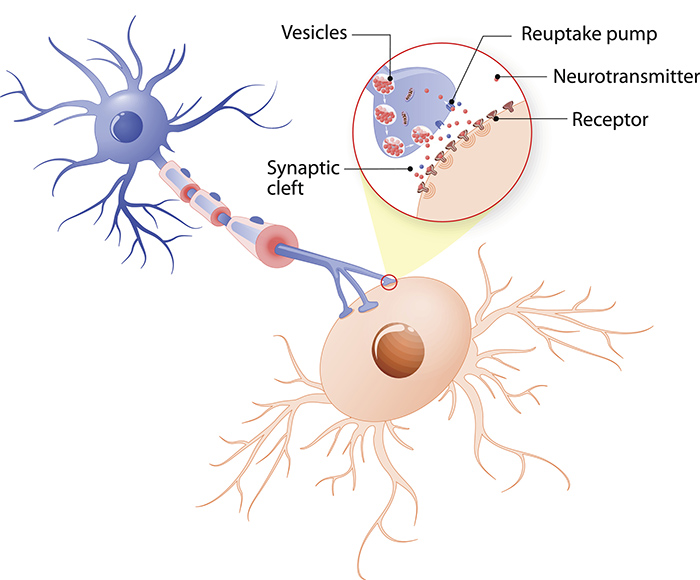
Neurotransmitters are chemical messengers in the body. They send signals in the body’s nervous system by triggering electrical impulses. They also provoke reactions by effector organs such as muscle contraction or hormone release. Based on what they trigger, neurotransmitters are either excitatory or inhibitory. Excitatory neurotransmitters trigger depolarization, which increases the likelihood of a response. On the other hand, inhibitory neurotransmitters prompt hyperpolarization, which decreases the likelihood of a response.
Examples of Neurotransmitters



- Acetylcholine (Ach) affects REM sleep, learning, memory, and movement.
- Dopamine (DPA) affects learning, pleasure, reinforcement, attention, and movement.
- Norepinephrine (NE) affects wakefulness, alertness, and eating.
- Epinephrine affects energy release while exercising and metabolism of glucose.
- Serotonin affects aggression, mood, sleep, impulsivity, and appetite.
- Glutamate involves in learning and emotion. It is the most common brain neurotransmitter.
- Endorphins provide relief from pain and effects feelings of pleasure.
- Adrenaline increases the heart rate and blood flow when produced during exciting or stressful situations.
- Noradrenaline, contrary to adrenaline, improves attention by increasing blood flow and contracting blood vessels.
- GABA contributes to vision and motor control. High levels of GABA improve focus, yet low levels cause anxiety.
Neurotransmitter Receptors

Receptors proteins are activated by neurotransmitters. Ligand-activated ion channels are membrane-spanning proteins that open in response to ligand binding and experience a change in shape. These channels produce rapid physiological reactions. Initially, ions start to cross the membrane and cause a current through neurotransmitter binding. Then the current stops when the neurotransmitter is no longer bound to receptors. With the help of enzymes or neighboring cells, the neurotransmitter is removed from the synapse in a short time.
In the case of metabotropic receptors, neurotransmitter binding prompts a signaling pathway, which indirectly open or close channels. Signaling through these types of receptors are more complex and slower since several molecules inside the cell have to be activated. Metabotropic receptors may cause changes in cell response to a second neurotransmitter acting through a ligand-activated channel. They can also impact cells that do not involve ion channels such as postsynaptic cells.
Unconventional Transmitters
Recently, some neurotransmitters have been identified that do not follow the usual rules regarding conventional neurotransmitters. A couple of examples are endocannabinoids and gasotransmitters. They do not follow typical regulations in that they can carry messages from the postsynaptic neuron to the presynaptic neuron. They are also not stored in synaptic vesicles. Moreover, they can cross the cell membrane to directly communicate with target cells inside the cell without having to interact with receptors.
Works Cited
“What Are Neurotransmitters?” Queensland Brain Institute, 9 Nov. 2017, qbi.uq.edu.au/brain/brain-physiology/what-are-neurotransmitters.
“Neurotransmitters and Receptors.” Khan Academy, Khan Academy, http://www.khanacademy.org/science/biology/human-biology/neuron-nervous-system/a/neurotransmitters-their-receptors.
“Major Neurotransmitters and Their Functions.” Quizlet, quizlet.com/6847241/major-neurotransmitters-and-their-functions-flash-cards/.
“Brent Cornell.” Intestinal Villi | BioNinja, ib.bioninja.com.au/standard-level/topic-6-human-physiology/65-neurons-and-synapses/types-of-neurotransmitters.html.
Leave a comment